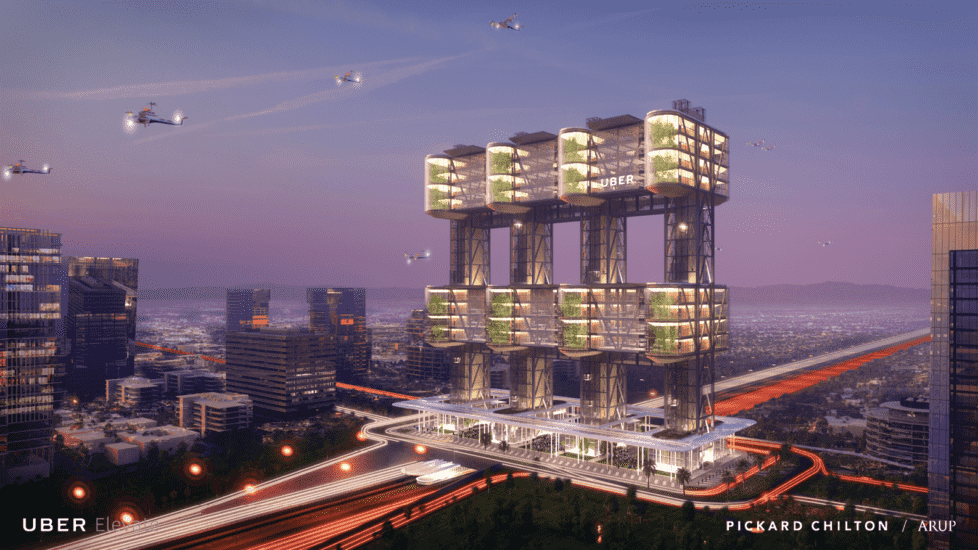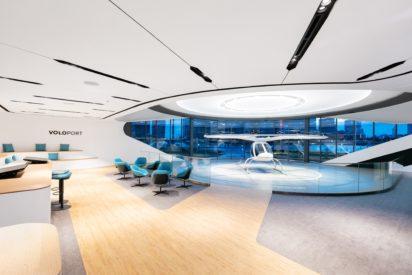Vertiports: If You Build Them, Will They Come?

Horse, stable. Ship, dock. Car, garage. Airplane, hangar. Air transportation vehicles need a place to park, too.
Whether to refuel, recharge, or reload, the urban air mobility (UAM) vehicles in development today will need somewhere to depart from and somewhere to land. They will need infrastructure to support them, not the least of which will be vertiports.
A vertiport isn’t an airport, and it isn’t a helipad (though it’s close). There are substantial differences, critical considerations that vertiport designers and builders must take into account while planning for the facilities that everyone, from passengers to pilots, will navigate as they take to the urban skies to get from intraurban Point A to Point B.
Reducing eVTOL Noise Impacts
eVTOL manufacturers, vertiport developers, and regulators all seem to agree on one thing: If eVTOLs are too noisy, these things “won’t fly.” Along with safety, the issue of noise management is front and center in the efforts to make eVTOLs and UAM commonplace in the near future.
Everyone agrees helicopters are noisy. But there aren’t dozens, let alone hundreds, of them traversing the skies over urban and suburban landscapes.
Speaking at a Vertical Flight Society webinar, David Josephson, with Josephson Engineering in Santa Cruz, California, explains that “the physics of sound, the physiology of sound perception in the brain, and our experience with noise events combine to form whether a noise is acceptable or objectionable.”
The noise emissions that people experience will need to be studied on the ground in real-time, over a day, a week, perhaps even over the course of a year to determine if they are palatable to the communities eVTOLs want to serve.
Measuring the operational noise, ambient noise, and how the noise is perceived, is crucial. Regulatory acceptance does not automatically equate to community acceptance. The physics, physiological, and psychological elements must all be taken into consideration.
Most eVTOL manufacturers proclaim their vehicles will be a magnitude or several magnitudes of noise quieter than today’s helicopters. But no one really knows what that means in practice. Yes, an eVTOL might be X db quieter than a Sikorsky S-92, but what happens, what does it sound like, on the ground when 50 of them are crisscrossing the skies 1,000 or 2,000 feet overhead?
Engineering firms such as Arup (which originated in London, but now has offices in more than 30 countries) are using technologies, such as the Arup SoundLab—an immersive 3D audio listening environment—to auralize (an acoustic render) what noise will be generated at altitude, during takeoff and landing, and during maneuvering.
This information will give stakeholders in the community some notion of what UAM will sound like and allow policymakers to make informed decisions, says Ryan Biziorek, an Arup acoustics engineer.
Ready for Takeoff . . . and Landing
Duncan Walker, CEO of UK-based Skyports, is focused on developing and operating takeoff and landing infrastructure for passenger and drone eVTOLs. Their “vertiports incorporate full landside and airside facilities” for passengers and operators, Walker says.
Safety, site selection (to build citywide networks of vertiports), power grid access and capacity, and emergency response and evacuation, are all elements Skyports takes into consideration during planning.
The issue of “sky clutter,” what some call “visual noise,” is of concern to manufacturers, operators, and infrastructure developers. A single bumblebee buzzing around you is annoying. A swarm is more than disconcerting. Similarly, the notion of dozens or even hundreds of UAM—passenger or drone —overhead is concerning to community planners.
Also, key, according to Byron Thurber, senior aviation planner at Arup, and Skyport’s Walker, is community acceptance of the vertiport. Whether it’s a single-story, ground-based, or a rooftop facility, the locals need to buy in. Community buy-in will require both popular support and approvals from local agencies such as planning, zoning, and transportation, depending on the jurisdiction.
Will they parallel freeways where noise is already present? Likely. Also likely is that the FAA’s and NASA’s existing certification processes will be used to certify eVTOLs and vertiports. The process may not be exactly the same as for airplanes and helicopters, but many of the same standards and principles will guide the eVTOL and vertiport process.
Skyports anticipates that by 2030 they will be called on to design and build between 10-15 vertiports in a given city, perhaps Singapore. They are already working in Singapore with Volocopter to provide the world’s first air taxi service, perhaps by late 2022 or early 2023.
Coming Soon to the Sky Above Your Neighborhood
From horses to wagons to automobiles and airplanes, one thing is sure: The next phase in the evolution of transportation is coming. What the vehicles look like, sound like, and “feel” like is still somewhat up in the air. But, however it plays out, vertiports will be part of UAM infrastructure as sure as the sun rises in the east and sets in the west.
Want to continue to stay up-to-date about the latest developments in the eVTOL industry? Subscribe to AeroCar Journal now. It’s FREE (for a limited time)!
Join us on Twitter for the latest news, analysis, and insight in the eVTOL industry. AeroCarJ



